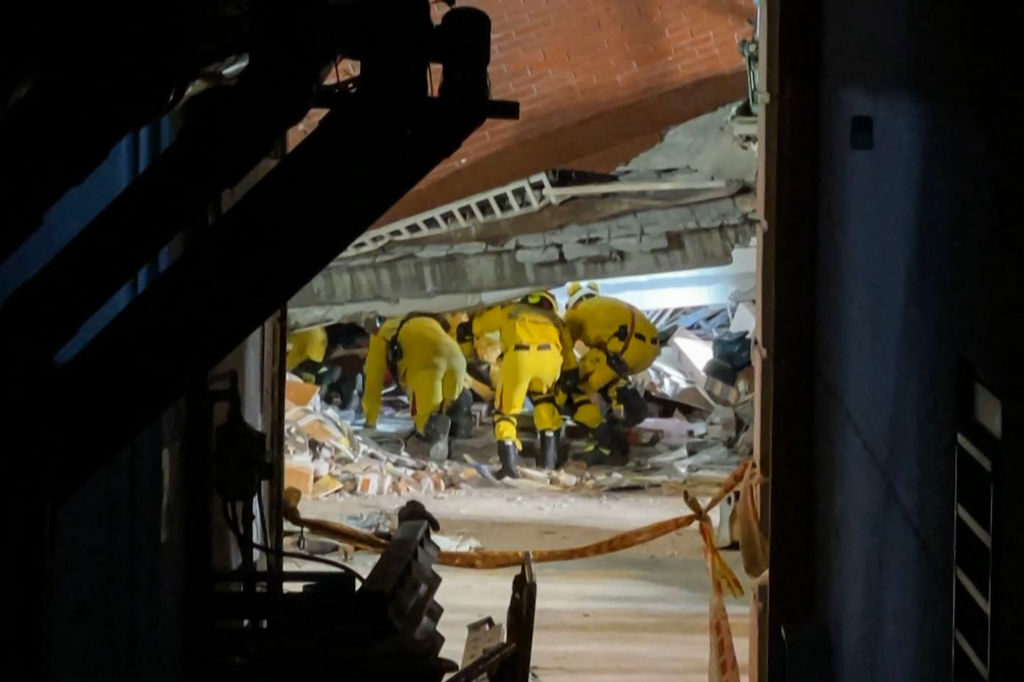Taiwan: 9 Dead, 50 Missing, over 800 Injured, Dozens Trapped in Tunnels After Massive Quake
Taiwan was hit by its strongest earthquake in 25 years during rush hour on Wednesday, with nine dead, 50 missing, and over 800 injuries reported.
Beibin Street, Hualien City, Hualien County, eastern Taiwan. #earthquake pic.twitter.com/J9jJIToCxZ
— Focus Taiwan (CNA English News) (@Focus_Taiwan) April 3, 2024
The quake triggered landslides in mountainous regions and caused buildings and tunnels to collapse, trapping 137 people in cars, buses, and tunnels. 87,000 homes are reportedly without power.
UPDATE: The death toll from this morning’s earthquake has now reached seven, with 736 injuries and 77 people remaining trapped or stranded. All of the deceased were hikers or motorists hit by falling rocks in Hualien Countyhttps://t.co/VK4Rbhvrqk pic.twitter.com/US8DCY2bRr
— Taipei Times (@taipei_times) April 3, 2024
Taiwanese officials said the quake was magnitude 7.2, while the U.S. Geological Survey recorded 7.4 and Japanese seismologists reported an even stronger reading of 7.7. The epicenter of the earthquake was located roughly 11 miles from the city of Hualien, which suffered a magnitude 7.3 earthquake in September 1999.
Taiwanese seismologists said the 1999 quake unleashed more destructive energy, and struck an area where more buildings were in danger of collapse, but Wednesday’s quake came close to its intensity. Both quakes were strong enough to not only knock people off their feet, but actually fling them into the air.
Lower intensity quake effects were felt in other major cities, including the capital of Taipei, where damage was reported to the building that houses the national legislature.

Rescue work continues near a partially collapsed building after a powerful 7.3-magnitude earthquake rocked the entire island on April 3, 2024 in Hualien County, Taiwan. (Photo by VCG/VCG via Getty Images)
Seismologists warned dangerous aftershocks are possible over the next three to four days.
Transportation Minister Wang Kwo-tsai said on Wednesday morning that the transportation system in eastern Taiwan was paralyzed by the earthquake, including both road and rail traffic. He anticipated it would be several days before rail services could be restored.
Wang said his ministry is establishing maritime transportation along the mountainous eastern coast, plus extra passenger flights to the area. He cautioned that landing capacity at Hualien regional airports was limited, and airlines were already dealing with high travel demand for the annual Tomb Sweeping Festival holiday, which runs from April 4-7 this year.
Eyewitnesses in the earthquake region reported seeing landslides and huge clouds of dust in the mountains, while buildings partially collapsed or were tilted at strange angles in Hualien.
Several of the fatalities from the earthquake were hikers and park officials caught in the hills when the quake sent rocks crashing down around them. At least five deaths had been caused by falling rocks as of Wednesday morning, including a man found dead in his car after it was smashed by a rockfall.
A Hualien resident told the UK Guardian there was chaos in the streets when the quake struck as drivers slammed on their brakes or leapt off their bikes. People screamed as tremors “kept coming every few minutes, for many hours.”
A Hualien hostel owner mourned the destruction to the beautiful mountain parks that brought tourists to the area.
“We won’t know how long it will take for repairs to be made, or for guests to think about returning here. The road connecting Hualien with the north has been completely destroyed,” she said. “This is the most serious damage to infrastructure we have ever seen.”
The ten-story building seen tilted precariously on its side in many photos of post-quake Hualien is called the Uranus Building. It contains a mixture of residences and shops. Local reporters said many of the residents fled from the structure, but some are still unaccounted for, and rescue workers fear people could be trapped in the basement.
Condolences and offers of assistance poured in from across the Pacific and around the world, including messages from Indian Prime Minister Narendra Modi, Philippine President Ferdinand Marcos, Jr., and Japanese Prime Minister Kishida Fumio.

This frame grab from AFPTV video taken on April 3, 2024 shows rescue workers searching for survivors at the damaged Uranus Building in Hualien, after a major earthquake hit Taiwan’s east. (STR/AFPTV/AFP via Getty Images)
Kishida said it was “utterly heartbreaking” to hear of a massive earthquake striking “our neighbor across the sea.” He recalled Taiwan’s support for the Japanese people after recent earthquakes and pledged that Japan “stands ready to provide necessary support” in Taiwan’s hour of need.
White House national security spokeswoman Adrienne Watson released a brief statement saying the U.S. “stands ready to provide any necessary assistance,” and “all those affected are in our prayers.”
“The outpouring of global support is uplifting and deeply appreciated, as are the endeavors of our brave responders,” said Taiwan’s incoming President Willian Lai Ching-te.
“My thoughts are with all affected as we work to recover and rebuild,” he said, pledging that response efforts “are in full swing.”
Taiwan’s Mainland Affairs Council released a frosty statement on Wednesday morning rebuffing an offer of assistance from the People’s Republic of China.
“We noticed that the mainland’s Taiwan Affairs Office had expressed concern about the earthquake in waters off Hualien this morning. We greatly appreciate its concern, but there is no need for the mainland side to assist us in disaster relief,” the Taiwanese office said.





Comments are closed.